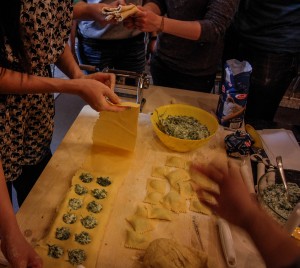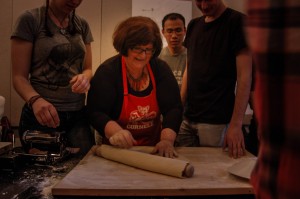Eating Italian food at a restaurant doesn’t quite cut it (Although we discover in the class Contemporary Italy: Politics and Society that Italian food doesn’t actually exist) , I mean, to truly experience a culture, you have to learn how to make the food yourself, not just eat it.
The process of making ravioli and fettuccine from scratch isn’t too complicated, but requires a few pieces of special equipment. The process also raised an interesting concept: That food from all over the world is actually pretty similar, but different enough to be different, of course. When filling in the ravioli dough with spinach, one of my peers made a parallel to making Chinese dumplings, and when slicing the fettuccine noodles (from what appears to be a roll of dough but is actually noodle-thin layers of dough on top of each other) a comparison to cutting sushi rolls was made. As simple as these observations may be, they bring into perspective the differences and similarities of cultures around the world- and how at the end of the day, we’re all human and do things in similar yet different ways.
Thanks to the wonderful human beings leading the Cornell in Rome program and head chef Anna Rita, my peers and I were in for a treat. After the kneading, rolling, cutting, filling, and boiling, it was finally time to eat. We left with bellies and take-home containers full. Although the pasta we made that night is now long gone, these warm culinary memories of our time together in Rome linger on in our minds.


